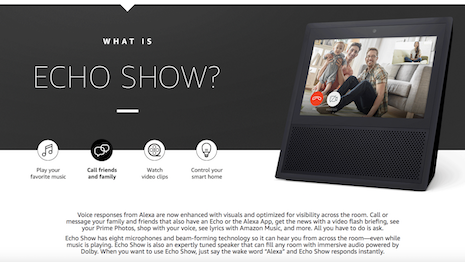- About
- Subscribe Now
- New York,
May 10, 2017

 Releasing June 28, Amazon's new Echo Show intelligent personal assistant will play music, allow phone calls, run video clips and control the smart home. Image credits: Amazon
Releasing June 28, Amazon's new Echo Show intelligent personal assistant will play music, allow phone calls, run video clips and control the smart home. Image credits: Amazon
The luxury market, like many industries, is affected by the rapid shift to intelligent versus smart devices and systems. Here are some top trends that point to rapidly changing consumer expectations, which itself will transform luxury.
An artificial intelligence (AI)-first world: The mobile-first world is being replaced by an AI-first world.
Consumers are increasingly using automated applications, influencing overall Internet of Things (IoT) adoption.
Two in five consumers believe smartphones will learn their habits and perform activities on their behalf automatically. One in two believes they will be able to talk to an household appliance.
 Dan Hodges is CEO of Consumers in Motion
Dan Hodges is CEO of Consumers in Motion
AI will end the screen age.
One in two smartphones users now thinks that smartphones will be a thing of the past, and that this will happen in just five years.
Artificial intelligence will allow consumers to interact with objects around them without having to use a smartphone screen.
IoT everywhere: Wearables are the first phase of IoT everywhere.
The future of wearables is not a connected watch. For example, with the Cicret Bracelet, you can make your skin your new touchscreen. That is the future of wearable devices.
The maker of the Cicret bracelet claims it turns the skin into a touchscreen. Some are skeptical
Context-aware personalization: Belgian startup Sentiance uses ambient intelligence and mines sensor data from smartphones and wearable devices. It taps AI to build context-aware, personalized profiles that can be used by its clients to increase engagement, conversion and retention.
Merged reality: Almost four out of five virtual reality users believe VR will be indistinguishable from reality in only three years.
Half of respondents are already interested in gloves or shoes that allow you to interact with virtual objects.
V-commerce: Virtual reality headsets allow shoppers at a Tommy Hilfiger store in New York who might never attend a fashion show to view and shop the season’s runway styles.
VR headsets will be installed in the brand’s biggest flagship stores in the United States and Europe.
V-cinema: Virtual reality is the new cinema experience. The future of social VR is here.
Graphene: What is graphene and why should brands and marketers care?
Graphene is one of the most versatile substances available to mankind. The first 2D atomic crystal – a single layer of carbon atoms – it is the thinnest object ever obtained: a million times thinner than a human hair. It is also the world’s strongest material, stronger than a diamond, 200 times stronger than steel, and yet lightweight and flexible.
Brands and marketers need to be aware of the coming world of flexible smart-screen technology.
One particular area in which we will soon begin to see graphene used on a commercial scale is on liquid crystal displays (LCD).
Graphene LCD touchscreens for smartphones, tablets, desktop computers and televisions are in the early stages of development.
In terms of potential real-world electronic applications, we can eventually expect to see such devices as graphene based e-paper with the ability to display interactive and updatable information, and flexible electronic devices including portable computers and televisions.
Amazon is aggressively moving into an AI-driven home hubs with rivals such as Google Home and Apple Siri
Daniel Hodges is CEO of Consumers in Motion Group, New York. Reach him at dan@consumersinmotion.com.
Share your thoughts. Click here